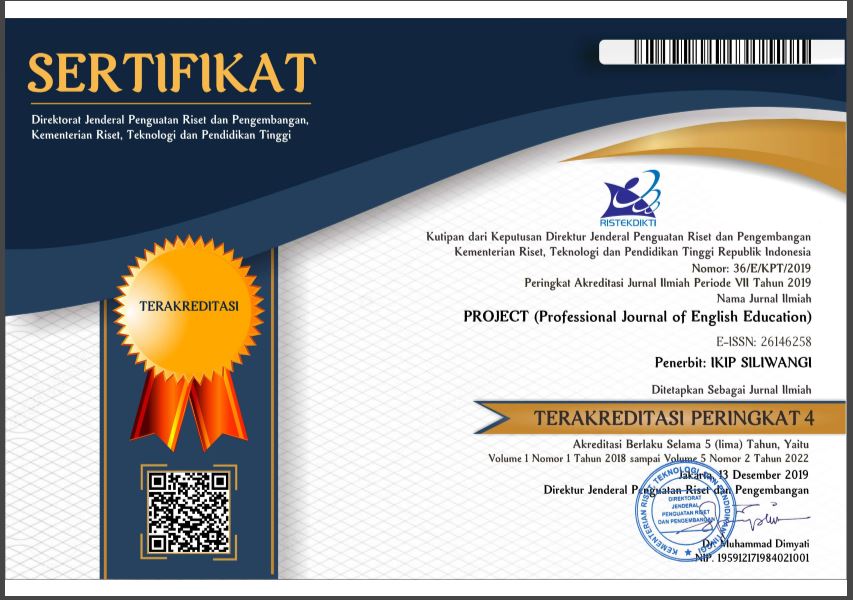INVESTIGATING TEACHING MATERIALS IN AN EFL READING CLASSROOM
Abstract
This research is aimed at investigating teaching materials development in an EFL reading classroom, specifically, it is focused on the factors need to be considered in preparing/developing reading materials, and students’ perception towards reading materials used by the teacher. This research used qualitative case study. The data were collected through interview from teacher and students, and documentation analysis using lesson plan. The site of this research is in one of Tangerang public school. And main participants are 1 English teacher and 3 students. The findings of this research showed that in preparing reading material the teacher involved several factors, including relevance to student live and interest, vocabulary level and complexity of the text, the use of technology and students’ feedback. The results of analysis on students’ perception on reading materials used by the teacher revealed that the students prefered reading material that has simplicity and imaginative content, enjoy reading material that have visual, value effective feedback mechanism, and acknowledge the role of reading material in English skill improvement. However, the students faced difficulties on reading material due the scientific language and text length.
References
Anggia, H., & Habók , A. (2023). Textual complexity adjustments to the English reading comprehension test for undergraduate EFL students. Heliyon, 9(1)
Asyura, C. D., & Fitriawati, F. (2021). Students’ Need Analysis on Critical Reading Learning Material at English Department of Universitas Negeri Padang. Journal of English Language Teaching, 10(3), 462-474.
Aydın, E., & Kaya, M. (2021). Students' Perceptions on the Effect of Text Length on Their Vocabulary Success. International Journal of Education and Literacy Studies, 9(2), 79-89.
Ayu, M., Dien, C. D., & Vianty, M. (2017). Secondary School Students' English Literacy: Use of Interactive Read Aloud Instructional Strategy. International Journal of Applied Linguistics and English Literature, 6(7), 292-299.
Biria, R., & Boshrabadi, A. M. (2015). Towards developing a multi-aspectual framework for systematic evaluation of locally prepared ELT materials. English Teaching: Practice & Critique. 14(2), 164-186
Braun, V., & Clarke, V. (2006). Using Thematic Analysis in Psychology. Qualitative research in psychology, 3(2), 77–101
Christ, T., Arya, P., & Chiu, M. M. (2021). Professor and institution characteristics: Relations to technology use and teacher preparation in literacy methods courses. Journal of Digital Learning in Teacher Education, 38(1), 33–53.
Creswell, J. W. (2014). Research design: Qualitative, quantitative, and mixed method (4th ed.). SAGE Publications. (pp.398)
Eryanti, Danim, S., Yulistio, D., & Wardhana, D. E. (2021). The Influence of the School Literacy Movement, Reading Interest, and Reading Materials on Reading Comprehension Skill of Class XI Students of MAN Bengkulu City Academic Year 2020/2021. International Journal of Multicultural and Multirelogious Understanding, 8(9), 432-441
Feger, M. V. (2006). "I Want to Read": How Culturally Relevant Texts Increase Student Engagement in Reading. Multicultural Education, 13(3), 18-18.
Grabe, W., & Stoller, F. L. (2002). Teaching and Researching Reading. Routledge.
Jenkins, J. R., & Pany, D. (1981). Instructional Variables in Reading Comprehension. In Comprehension and teaching: Research reviews (pp. 163-202)
Lestari, R. P., Fitriani, S. S., & Erdiana, N. (2017). Reading comprehension difficulties encountered by senior high school EFL students. Research in English and Education Journal, 2(2), 110-118.
Leu, D. J., & Kinzer, C. K. (1987). Effective Reading Instruction in the Elementary Grades. Ohio: Merril Publishing Company.
Li, H., & Gan, Z. (2022). Reading motivation, self-regulated reading strategies and English vocabulary knowledge: Which most predicted students’ English reading comprehension?. Frontiers in Psychology, 13, 1041870
Menggo, S., Ndiung, S., & Midun, H. (2022). Integrating 21st-century skills in English material development: What do college students really need? Englisia: Journal of Language, Education, and Humanities, 9(2), 165-186
Miftakh, F. (2018). The Relevance Between An ESP Syllabus And The Students’ Needs. Journal of English Education Studies, 1(1), 20-30.
Moreillon, J. (2007). Collaborative Strategies for Teaching Reading Comprehension: Maximizing Your Impact . Chicago: American Library Association.
Morris, R., Perry, T., & Wardle, L. (2021). Formative assessment and feedback forlearning in higher education: A systematic review. Review of Education, 9(3), e3292.
Nazila, D. K., Adisaputera, A., & Saragih, A. (2020). Development of Teaching Material for Short Story Writing Experience Based on 7th Grade Students of Junior High School 2 Kejuruan Muda. Budapest International Research and Critics in Linguistics and Education (BirLE), 3(2), 1137-1150.
Nuraini, K. (2016). Factors considered in developing materials for teaching English to young learners. In International Conference on Education (IECO) FKIP UNMUH JEMBER, 1(1)
Puspitarini, Y. D., & Hanif, M. (2019). Using Learning Media to Increase Learning Motivation in Elementary School. Anatolian Journal of Education, 4(2), 53-60.
Richards, J. C., & Rodgers, T. (1982). Method: Approach, Design, and Procedure. TESOL Quarterly, 16(2), 153-168.
Samat, M. S., & Aziz, A. A. (2020). The effectiveness of multimedia learning in enhancing reading comprehension among indigenous pupils. Arab World English Journal (AWEJ), Vol. 11
Schaaf, R. L., & Mohan, N. (2016). Game on: Using digital games for 21st-century teaching, learning, and assessment. Solution Tree Press.
Sembiring, R. A. (2019). The Students’ Ability in Reading Comprehension in Narrative Text. Saltel Jurnal, 2, 36-44
Snow, C. E. (2002). Reading for Understanding: Toward an R&D Program in Reading Comprehension. Rand Corporation.
Snow, C. (2004). Reading Next: A Vision for Action and Research in Middle and High School Literacy. Alliance for Excellent Education.
Ürün, M. F., & Yarar, G. (2015). A Study on Needs Analysis in English Language Teaching.
Waterman, T. (2019). Negotiating course material to counter poor learner motivation. Learning and Teaching in Higher Education: Gulf Perspective, 15(2), 30-46
Downloads
Published
Issue
Section
License

This work is licensed under a Creative Commons Attribution-ShareAlike 4.0 International License.




